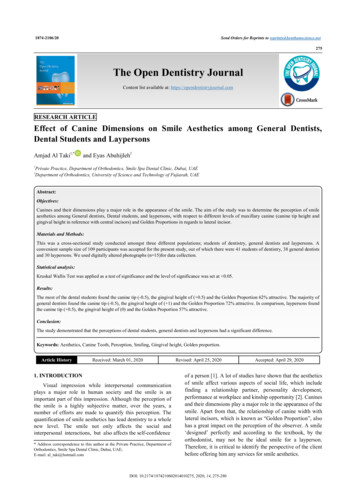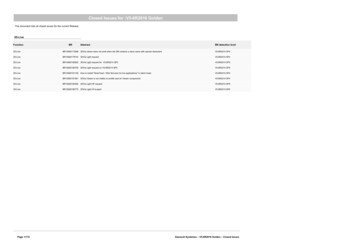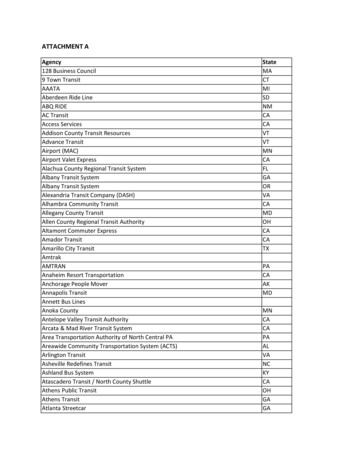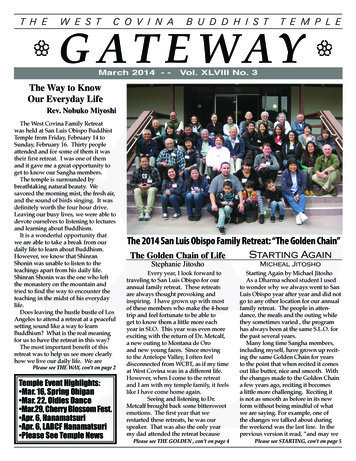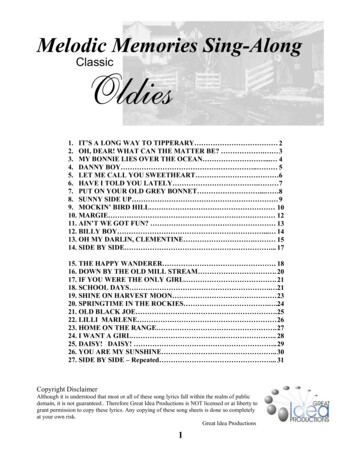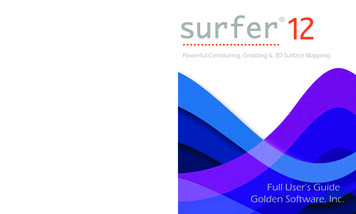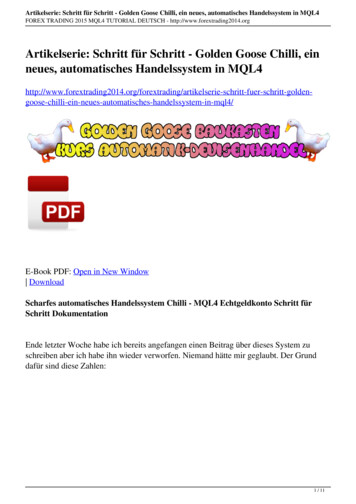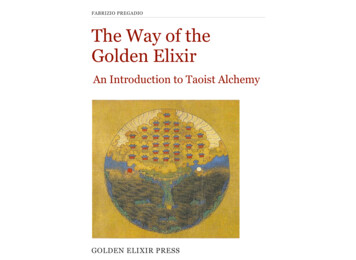
Transcription
FABRIZIO PREGADIOThe Way of theGolden ElixirAn Introduction to Taoist AlchemyGOLDEN ELIXIR PRESS
The Way of the Golden ElixirAn Introduction to Taoist AlchemyFabrizio PregadioThird EditionGolden Elixir PressMountain View, CAwww.goldenelixir.com press@goldenelixir.comFirst edition Fabrizio Pregadio and Golden Elixir Press 2012Second edition Fabrizio Pregadio and Golden Elixir Press 2014Third edition Fabrizio Pregadio and Golden Elixir Press 2019Words in bold are defined in the Glossary. Click or tap to read a definition.All external links in this e-book are secure links to the Golden Elixir website (www.goldenelixir.com).i
C HAPTER 1Introduction
S ECTION 1Waidan and NeidanChinese alchemy has a history of more than two thousand years, recorded from the 2nd century BCE to thepresent day. It is divided into two main branches,known as Waidan, or External Alchemy, and Neidan,or Internal Alchemy, which share part of their doctrinal foundations but differ in the respective practices.Waidan (lit., “external elixir”), which arose earlier, isbased on the compounding of elixirs through the heating of natural substances in a crucible. Its texts consistof recipes, along with descriptions of ingredients, ritualrules, and passages concerned with the cosmological associations of minerals, metals, instruments, and operations. Neidan (lit., “internal elixir”) borrows a significant part of its vocabulary and imagery from its earliercounterpart, but aims to produce the elixir within thealchemist’s person according to two main models ofdoctrine and practice: first, by causing the primarycomponents of the cosmos and the human being to revert to their original condition; and second, by purifying the mind from defilements and passions in order to“see one’s Nature.” Neidan texts cover a wider spectrum of subjects compared to Waidan; at its ends are,on the one hand, teachings on the Dao and, on theother, descriptions of physiological practices.Fig. 1. Qian (right) and Kun (left), images of the maleand female principles conjoined by the alchemist.2
The main designations of the elixir are huandan, or Reverted Elixir, and—especially in the “internal” branch—jindan, or Golden Elixir. On the basis of this term,the authors of alchemical texts often call their traditionthe Way of the Golden Elixir (jindan zhi dao).B ASIC D OCTRINESNeither alchemy as a whole, nor Waidan or Neidan individually, constitutes a Taoist “school” with a definitecanonical corpus and a single line of transmission. Onthe contrary, each of the two main branches displays aremarkable variety of doctrinal statements and formsof practice. Nevertheless, beyond its different formulations, the Way of the Golden Elixir is characterized by afoundation in doctrinal principles first set out in thefounding texts of Taoism—especially the Daode jing, orBook of the Way and its Virtue—concerning the relation between the Dao and the world. The cosmos as weknow it is conceived of as the last stage in a series oftransformations from Non-Being (wu) to Unity (yi), duality (Yin and Yang), and finally multiplicity (wanwu,the “ten thousand things”). The alchemist intends to retrace this process backwards. The practice should beperformed under close supervision of a master, whoprovides the “oral instructions” (koujue) necessary toFig. 2. Chart of the Fire Phases (huohou). Each ring shows oneof the sets of cosmological emblems used in alchemy and itscorrespondences with the other sets. See a detailed description.Yu Yan (1258–1314), Yiwai biezhuan (A SeparateTransmission Outside the Book of Changes).understand the processes that adepts perform with minerals and metals, or undergo within themselves.3
In both Waidan and Neidan, the practice is variouslysaid to grant transcendence (a state described by suchexpressions as “joining with the Dao”), immortality(usually meant as a spiritual condition), longevity, healing (either in a broad sense or with regard to specific illnesses), and—especially in Waidan—communicationwith the deities of the celestial pantheon and protection from spirits, demons, and other malignant entities.Modern study of the Chinese alchemical literature began in the past century, after the Canon was for thefirst time reprinted and made widely available in 1926.Among the main contributions in Western languagesone may cite those by Joseph Needham (1900–95), HoPeng Yoke (1926–2014), and Nathan Sivin for Waidan;and Isabelle Robinet (1932–2000), Farzeen BaldrianHussein (1945–2009), and Catherine Despeux for Neidan.T HE A LCHEMICAL C ORPUSF URTHER R EADINGS IN THE G OLDEN E LIXIRWhile historical and literary sources, including poetry,provide many relevant details, the main repository ofChinese alchemical sources is the Taoist Canon (Daozang), the largest collection of Taoist works. About onefifth of its 1,500 texts are closely related to the variousWaidan and Neidan traditions that developed until themid-15th century, when the present-day edition ofCanon was compiled and printed. Several later texts, belonging to Neidan, are found in the Daozang jiyao (Essentials of the Taoist Canon, originally compiledaround 1800 and expanded in 1906), and many othershave been published in smaller collections or as independent works.W EBSITEGeneral introductions to Taoist thought and religion: Daojia (Taoism; “Lineage[s] of the Way”) (Isabelle Robinet, from The Encyclopedia of Taoism) Daojiao (Taoism; Taoist teaching) (T.H. Barrett, fromThe Encyclopedia of Taoism)On the Daode jing (Book of the Way and Its Virtue), thetext that Taoists place at the origins of their tradition: Laozi and the Daode jing (Fabrizio Pregadio, from theStanford Encyclopedia of Philosophy)On the Taoist Canon and other collections containing alchemical tests:4
Daozang and Subsidiary Compilations (Judith M.Boltz, from The Encyclopedia of Taoism)General introduction to Chinese alchemy: Jindan (Golden Elixir) (Fabrizio Pregadio, from The Encyclopedia of Taoism)On Yin and Yang and their use in alchemy: Yin and Yang Yin and Yang in Internal Alchemy (Isabelle Robinet,from her The World Upside Down)5
C HAPTER 2Early Chinese Alchemy
S ECTION 2Origins of WaidanFig. 3. An alchemical altar.Shangqing jiuzhen zhongjing neijue (Inner Instructions onthe Central Book of the Nine Realized Ones of the HighestClarity).From a historical point of view, nothing is known aboutthe beginnings of alchemy in China. The early sourcesattribute doctrines and methods of Waidan to deitieswho first transmitted them to one another in the heavens and finally revealed them to humanity. Other records consists of tales on the search of immortality, orof legends on a “medicine of deathlessness” found inthe paradises of the Immortals.Several sources and studies have associated the originsof alchemy with the fangshi (“masters of methods”), anumerous and eclectic group of practitioners of different techniques who were often admitted to court by emperors and local rulers during the Han dynasty (2ndcentury BCE–2nd century CE) and later. Their main areas of expertise were astrology, numerology, divination, exorcism, and medicine. Although historical records indicate that few fangshi were involved in making elixirs, one of them is associated with the first mention of alchemy in China. Around 133 BCE, Li Shaojunsuggested to Emperor Wu of the Han that he should follow the example of the mythical Yellow Emperor(Huangdi), who had performed an alchemical methodat the beginning of human history. Li Shaojun said thatthe emperor should perform offerings to an alchemicalstove in order to summon supernatural beings, inwhose presence cinnabar would transmute itself into7
gold. Eating and drinking from cups and dishes madeof that gold would prolong the emperor’s life and enable him to meet the Immortals. Then, after performing the major imperial ceremonies to Heaven andEarth, the emperor would obtain immortality 2.1(see Pregadio, Great Clarity, 28–30).2.1 Li Shaojun’s method[Li] Shaojun told the emperor: “By making offerings tothe stove, one can summon the supernatural beings(wu). If one summons them, cinnabar can betransmuted into gold. When gold has been producedand made into vessels for eating and drinking, one canprolong one’s life. If one’s life is prolonged, one will beable to meet the immortals of the Penglai Island in themidst of the sea. When one has seen them and hasperformed the Feng and Shan ceremonies, one willnever die. The Yellow Emperor did just so . . .Although this account shows that alchemy existed inChina by the 2nd century BCE, it does not describe anactual method for making an elixir. Li Shaojun’s elixir,moreover, was not meant to be ingested but only to beused for making vessels. The earliest mention of elixiringestion is found in the Yantie lun (Discussions onSalt and Iron), a work dating from ca. 60 BCE (see Pregadio, Great Clarity, 30–31). On the other hand, as weshall see in the next section, the ritual aspects involvedin Li Shaojun’s procedure continued to perform a major role in the later Waidan tradition.F URTHER R EADINGS IN THE G OLDEN E LIXIRW EBSITE The Elixir in External Alchemy (Waidan)Thereupon the emperor for the first time personallymade offerings to the stove. He sent several fangshi tothe sea to search for Penglai and for those like MasterAnqi, and also occupied himself with the transmutationof cinnabar and other substances into gold.Shiji (Records of the Historian), 288
S ECTION 3The Taiqing (Great Clarity)TraditionFig. 4. A talisman used to protect the compoundingof the elixirs.Huangdi jiuding shendan jingjue (Instructions onthe Book of the Divine Elixirs of the Nine Tripodsof the Yellow Emperor).Details about the first clearly identifiable tradition ofWaidan emerge about three centuries after Li Shaojun.Named after the heaven that granted its revelation, theTaiqing (Great Clarity) tradition originated in Jiangnan, the region south of the lower Yangzi River thatwas also crucial for the history of Taoism during theSix Dynasties (3rd–6th centuries).(*) The Taiqing textsand methods were first bestowed to the Yellow Emperor by the Mysterious Woman (Xuannü), one of histeachers in the esoteric arts. Later, around the year200, a “divine man” (shenren) revealed them to Zuo Ci,a Han-dynasty fangshi who is also involved in the origins of other Taoist traditions. The Taiqing texts thencame into the possession of the family of Ge Hong (283–343), who summarized them in his Baopu zi (Book of theMaster Who Embraces Spontaneous Nature).The three main Taiqing texts are the Taiqing jing (Bookof Great Clarity), the Jiudan jing (Book of the Nine Elixirs), and the Jinye jing (Book of the Golden Liquor). Asshown below, the versions of these works found in theTaoist Canon make it possible to reconstruct several essential aspects of early Chinese alchemy (see also Pregadio, Great Clarity).(*) Between the mid-4th and the early 5th centuries, this region gave light to the Shangqing (Highest Clarity) and theLingbao (Numinous Treasure) schools of Taoism.9
R ITUALIn Taiqing alchemy, compounding the elixir is the central part of a process involving several stages, each ofwhich is marked by the performance of rites and ceremonies. The alchemical practice consists of this entireprocess, and not only of the work at the furnace.To receive texts and oral instructions, the disciple offers tokens to his master and makes a vow of secrecy.Then he retires to a mountain or a secluded place withhis attendants and performs the preliminary purification practices, which consist of making ablutions andobserving the precepts for several months. He delimitsthe ritual space with talismans (fu) to protect it fromharmful influences, and builds at its center the Chamber of the Elixirs (danshi, i.e., the alchemical laboratory), in which only he and his attendants may enter.The furnace is placed at the center of the Chamber ofthe Elixirs.When the purification practices are completed, the firemay be started on a day indicated as propitious by thetraditional calendar. This stage is marked by an invocation 3.1 addressed to the highest gods, namely theGreat Lord of the Dao (Da Daojun) and his two attendants, Lord Lao (Laojun, the deified aspect of Laozi)and the Lord of Great Harmony (Taihe jun). From that3.1 The Taiqing RitualWhen you start the fire you should perform a ceremonybeside the crucible. Take five pints of good quality whiteliquor, three pounds of dried ox meat, the same amount ofdried mutton, two pints of yellow millet and rice, threepints of large dates, one peck of pears, thirty cookedchicken’s eggs, and three carp, each weighing threepounds. Place them on three stands, and on each standburn incense in two cups. Pay obeisance twice, and utterthe following invocation:“This petty man, (name of the adept), verily and entirelydevotes his thoughts to the Great Lord of the Dao, LordLao, and the Lord of Great Harmony. Alas! This petty man,(name of the adept), covets the Medicine of Life! Lead himso that the Medicine will not volatilize and be lost, butrather be fixed by fire! Let the Medicine be good andefficacious, let the transmutations take place withouthesitation, and let the Yellow and the White be entirelyfixed! When he ingests the Medicines, let him fly as animmortal, have audience at the Purple Palace (Zigong),(*)live an unending life, and become a realized man(zhenren)!”Offer the liquor, rise, and pay obeisance two more times.Finally offer kaya nuts, mandarins and pomelos. After that,the fire may be started according to the method.(*) The Purple Palace is in the constellation of the Northern Dipper,at the center of the cosmos.Jiudan jing (Book of the Nine Elixirs)10
moment, the alchemist’s attention focuses on the crucible, and he compounds the elixir following the instructions found in the texts and those received from hismaster. When the elixir is ready, he offers differentquantities of it to several deities. Finally, he pays againhomage to the gods, and ingests the elixir at dawn.M ETHODSBesides the ritual aspects, the Taiqing tradition is characterized by a set of fundamental methods 3.2. Themain features may be summarized as follows. The ingredients are placed in a crucible, which is closed by another overturned crucible. Under the action of fire,they transmute themselves and release their pure essences. At the end of the required number of days, thecrucible is left to cool and is then opened. The elixir hascoagulated under the upper part of the vessel. It is carefully collected, usually by means of a chicken’s feather,and other substances are added to it. In certain cases itis placed again in the crucible and is newly heated; otherwise it is stored to be ingested later.The ingredients most frequently used in the Taiqingtexts are mercury, realgar, orpiment, malachite, magnetite, and arsenolite. The main role in the alchemicalprocess, however, is played by the crucible. To repro-3.2 A Taiqing Alchemical MethodThe Fifth Divine Elixir is called Elixir in Pellet (erdan).Take one pound of mercury, and put it in a crucible[luted with the Mud] of the Six-and-One. Then take onepound of realgar, pound it until it becomes powder-like,and cover the mercury with it. Then take one pound ofhematite, pound it until it becomes powder-like, andcover the realgar with it. Close the crucible withanother crucible of the Six-and-One, seal the jointsluting them with the Mud of the Six-and-One, and let itdry.Place the crucible over a fire of horse manure or chafffor nine days and nine nights. Extinguish the fire, andplace the crucible over a fire of charcoal for nine daysand nine nights. Extinguish the fire, let the crucible coolfor one day and open it. The Medicine will have entirelysublimated, and will adhere to the upper crucible.Jiudan jing (Book of the Nine Elixirs)duce the inchoate state (hundun) of the cosmos at itsinception, the vessel should be hermetically sealed sothat Breath (qi) is not dispersed. For this purpose, amud made of seven ingredients is spread on its outerand inner surfaces and at the point of conjunction of itstwo halves. This compound is known as Mud of theSix-and-One (liuyi ni) or—to underline its importance11
3.3 Benefits of the ElixirsPracticing breathing and daoyin, exhaling the old andinhaling the new breath, and ingesting medicines ofherbs and plants can extend the length of one’s life,but does not allow one to escape death. When a maningests the Divine Elixirs, he becomes a divineimmortal and transcends the generations [ofmortals]. . . .The ten thousand gods will become your attendantsand offer protection, and the Jade Women will be atyour service. The divine immortals will welcome you,and you will rise to heaven. The hundred spirits, theGods of Soil and Grain, the Count of the Wind, and theMaster of Rain will welcome you, and you will havethem at your service. . . .If you want to keep away the five sorts of weapons,you should carry [the elixir] at your belt. Divine beingswill offer their protection and keep the weaponsaway. . . .If you walk keeping in your hand one pill [of the elixir] ofthe size of a date stone, the hundred demons will beexterminated. . . . This elixir will also keep off thievesand robbers, and even tigers and wolves will run away.If a woman who lives alone keeps one pill the size of alarge bean in her hand, the hundred demons, thieves,and robbers will flee and dare not come near her.Jiudan jing (Book of the Nine Elixirs)in the alchemical practice—Divine Mud (shenni). In several methods, a lead-mercury compound, representingthe conjunction of Heaven and Earth, or Yin and Yang,is also spread on the vessel or is placed within it withthe other ingredients.In the crucible, the ingredients “revert” (huan) to theiroriginal state (hence the name Reverted Elixir as a general designation of the elixirs). A 7th-century commentary to one of the Taiqing texts equates this refined matter with the “essence” (jing) that, as the Daode jingsays, is hidden within the womb of the Dao and givesbirth to the world: “Vague and indistinct! Within itthere is something. Dim and obscure! Within it there isan essence” (Daode jing, sec. 21). In this view, the elixiris a tangible sign of the seed that generates the cosmosand enables the self-manifestation of the Dao. Thisprima materia can be transmuted into alchemical gold.B ENEFITS OF THE E LIXIRSIngesting an elixir is said to confer transcendence, immortality, and admission into the ranks of the celestialbureaucracy 3.3. One also gains the ability to summon benevolent gods. Additionally, the elixir grantshealing from illnesses and protection from demons,spirits, and several other disturbances including weap12
ons, wild animals, and even thieves. To provide thesesupplementary benefits, the elixir does not need to beingested: it may simply be kept in one’s hand or carriedat one’s belt as a powerful apotropaic talisman.T AIQING A LCHEMY AND THE L ATER W AIDANF URTHER R EADINGS IN THE G OLDEN E LIXIRW EBSITE External Alchemy: Rituals External Alchemy: Methods External Alchemy: Benefits of the ElixirsT RADITIONThe Taiqing tradition shows that Chinese alchemy is, atthe beginning, a ritual practice performed to communicate with benevolent divinities and to expel dangerousspirits. The emphasis placed on ritual is closely relatedto another major feature of the Taiqing texts: none ofthem describes the alchemical process using the emblems, images, and language of Chinese cosmology andits system of correspondences. A few methods represent basic patterns such as Yin-Yang and the fiveagents (wuxing), but most involve the use of a largenumber of ingredients with no intention to reproducecosmological models. In addition, the Taiqing texts donot mention the trigrams and hexagrams of the Book ofChanges (Yijing) and the other emblems that, in thelater tradition, both Waidan and Neidan, will play a crucial role in framing the alchemical discourse and practice. (On the later Waidan traditions, see Sections 5and 6.)13
S ECTION 4Taoist Meditation and theOrigins of NeidanTo follow a historical sequence, we shall now take astep aside and look at the early Taoist traditionsbased on meditation on the inner gods. Teachings andpractices of these traditions differ remarkably fromthe Waidan methods that we have surveyed in the previous section, but they developed in the same region(Jiangnan) and at the same time (ca. 3rd-4th centuries) as Taiqing alchemy. Although these teachingsand practices do not constitute alchemy in the propersense of the word, they are essential to understandthe origins of Neidan from both a doctrinal and a historical point of view. (*)T HE I NNER G ODS AND THEIR N OURISHMENTThe main sources that document the early Taoist meditation practices are the Laozi zhongjing (Central Bookof Laozi) and the Huangting jing (Book of the YellowCourt). While the origins of these texts are unclear,they were transmitted by Taoist lineages in Jiangnanby the 3rd century.Both works describe the human being as host to a veritable pantheon of gods, the most important of whichFig. 5. Meditation on the gods of the heart.Dadong zhenjing (True Book of the Great Cavern).(*) This section is concerned only with the main analogies between meditation and Neidan. For a comprehensive descriptionof early Taoist meditation, see Robinet, Taoist Meditation.14
4.1 The Red Child. . . He resides precisely in the ducts of the stomach,the Great Granary. He sits facing due south on a couchof pearls and jade, and a flowery canopy of yellowclouds covers him. He wears clothes with pearls of fivehues. His mother resides above on his right, embracingand nourishing him; his father resides above on his left,instructing and defending him. . . .Therefore constantly think of (i.e., visualize) the RealizedMan Child-Cinnabar (Zidan) residing in the Palace ofthe stomach, the Great Granary. He sits facing duesouth, feeding on the Yellow Essence and the RedBreath, drinking and ingesting the Fount of Nectar (i.e.,the practitioner’s saliva). Child-Cinnabar, Original Yang,is nine tenths of an inch tall, but think of him as equalto yourself.Fig. 6. Meditation on the Child. Dadongzhenjing (True Book of the Great Cavern).represent the formless Dao or cosmological principlessuch as Yin and Yang or the five agents. In addition,the inner gods perform multiple roles: they enable thehuman being to communicate with the correspondinggods of the celestial pantheon, serve as administratorsLaozi zhongjing (Central Book of Laozi), 12of the human body, and preside over the balance of itsfunctions.The innermost deity is the Red Child (Chizi), who isalso called Zidan (Child-Cinnabar) 4.1. He resides inthe stomach—one of the multiple centers of the humanbody—and, like the Supreme Great One (ShangshangTaiyi, the highest god in heaven), he is a transforma15
tion of the Breath of the Dao. The Red Child is said torepresent one’s own “true self” (zhenwu). In this function, he is the precursor of the “embryo” and the “infant” that Neidan adepts, centuries later, would generate and nourish by means of their practices.To ensure that this and the other gods stay in theirresidences—their departure would provoke death—one should nourish them and their dwellings. In particular, adepts are instructed to visualize and circulate a “yellow essence” (huangjing) and a “redbreath” (chiqi) within their bodies, respectively associated with the Moon (Yin) and the Sun (Yang), andto deliver them to the gods 4.2. There are clearanalogies between these Yin and Yang essences andbreaths and those whereby, several centuries later, aNeidan adept would conceive and nourish his inner“embryo.”An additional source of nourishment of the gods is thepractitioner’s own salivary juices. These juices have thefunction of “irrigating” (guan) the inner organs inwhich the gods reside. Their names have clear alchemical connotations; they include Jade Liquor (yuye),Golden Nectar (jinli), and even Golden Liquor (jinye,the name of one of the Taiqing elixirs).4.2 Yellow Essence and Red BreathConstantly think that below the nipples are the Sun andthe Moon. Within the Sun and the Moon are a YellowEssence and a Red Breath that enter the CrimsonPalace (i.e., the heart); then again they enter the YellowCourt (the spleen) and the Purple Chamber (thegallbladder). The Yellow Essence and the Red Breaththoroughly fill the Great Granary (the stomach). TheRed Child is within the ducts of the stomach. He sitsfacing due south, drinking and eating the YellowEssence and the Red Breath until he is sated.Laozi zhongjing (Central Book of Laozi), 11Finally, one method in the Laozi zhongjing consists incausing the breaths (qi) of the heart (Yang) and the kidneys (Yin) to descend and rise within one’s body, respectively, so that they may conjoin. An analogous practice will be performed by Neidan adepts when they jointhe Fire of the heart and the Water of the kidneys (seeDespeux, Taoïsme et corps humain, 152–58).T HE E MBRYO IN S HANGQING T AOISMThe “interiorization” of Waidan is even clearer in theShangqing (Highest Clarity) tradition of Taoism, whichoriginated in the second half of the 4th century.(*) In16
support for meditation (see Bokenkamp, Early DaoistScriptures, 275–372; Pregadio, Great Clarity, 57-59).Second, and more important, the Shangqing scripturescontain methods for the creation of an immortal body,or an immortal self, by means of a return to a selfgenerated inner embryo. One example is the practice of“untying the knots” (jiejie), whereby an adept reexperiences his embryonic development in meditation.From month to month, beginning on the anniversary ofhis conception, he receives again the “breaths of theNine Heavens”—with another remarkable example ofalchemical imagery used in meditation practices, theyare called the Nine Elixirs (jiudan)—and each time oneof his inner organs is turned into gold or jade. Then hisOriginal Father and Original Mother issue breaths thatjoin at the center of his person and generate an immortal infant.Fig. 7. Continuity between Taoist meditation and InternalAlchemy. The Neidan embryo exiting from the sinciput of thepractitioner (compare fig. 6). Xingming guizhi (Principles ofConjoined Cultivation of Nature and Existence).heriting the traditions summarized above, Shangqingnewly codified them in two ways. First, it incorporatedcertain Waidan practices, but used them especially as aM EDITATION AND A LCHEMYThe examples seen above show that certain fundamental ideas, images, and practices that characterize Nei(*) Shangqing is one of two traditions that emerged from revelationsthat occurred in Jiangnan in the second half of the 4th century. Itsmethods are based on individual meditation practices. The other tradition is Lingbao (Sacred Treasure), which is mainly concerned with communal ritual.17
dan existed centuries before the beginning of its documented history. Most important among them is the image of the infant as a representation of the “true self”(fig. 6).Two essential features of Neidan, however, are not present in the Shangqing and the earlier meditation practices: the very idea of the Internal Elixir, and the use ofa cosmology that explains the generative process of thecosmos from the Dao, and serves at the same time toframe practices that reproduce that process in a reversesequence. In the next two sections, we shall look at theprocess that led to the birth of Internal Alchemy.F URTHER R EADINGS IN THE G OLDEN E LIXIRW EBSITEOn Taoist meditation on the inner gods: Inner Gods Selections from the Laozi zhongjing (Central Scripture of Laozi)On the Shangqing (Highest Clarity) school, one of themain precursors of Internal Alchemy: Shangqing (Highest Clarity) (Isabelle Robinet, fromThe Encyclopedia of Taoism)18
C HAPTER 3The Cantong qi and theBirth of Internal Alchemy
S ECTION 5The Cantong qi (Seal of theUnity of the Three)The foundations for both features mentioned at theend of the previous section—the concept of InternalElixir, and the use of the cosmological system to framethe “return to the Dao”—were provided by the Cantongqi, or Seal of the Unity of the Three, the main text inthe whole history of Chinese alchemy (see Pregadio,The Seal of the Unity of the Three). Under an allusivelanguage teeming with images and symbols, this work,almost entirely written in poetry, hides the expositionof the doctrine that gave birth to Neidan and inspired alarge number of other works. At least thirty-eight commentaries written from ca. 700 to the end of the 19thcentury are extant, and scores of Waidan and Neidantexts in the Taoist Canon and elsewhere are related toit (see Pregadio, The Seal of the Unity of the Three,Vol. 2).T WO M AIN R EADINGSFig. 8.Wei Boyang, the reputed author of the Cantong qi,compounds the Elixir with a disciple.The Cantong qi is traditionally attributed to WeiBoyang, an alchemist said to have lived around themid–2nd century and to come, once again, from theJiangnan region. This attribution, however, becamecurrent only at the end of the first millennium and wasupheld by the Neidan lineages, which have shaped thedominant reading of the Cantong qi.20
Along its history, Neidan has offered explications of thethe Cantong qi that differ in many details but have onepoint in common: this text is at the origins of InternalAlchemy and contains a complete illustration of its principles and methods. In this reading, the Cantong qi isnot only an alchemical text, but especially the first Neidan text. This understanding has deeply influenced thedevelopment of Chinese alchemy but faces two majorissues. First, the Cantong qi, supposedly written in the2nd century, does not play any visible influence on extant Waidan texts until the 7th century. Second, no alchemical or other source suggests that Neidan existedbefore the 8th century.Within the Taoist tradition there has also been a second, less well-known way of reading the Cant
The main designations of the elixir are huandan, or Re- verted Elixir, and—especially in the “internal” bran-ch—jindan, or Golden Elixir.On the basis of this term, t
